
Palazzo Antinori is a Renaissance palace located at the north end of Via de' Tornabuoni, where it makes an odd corner with Via dei Pecori, Via del Trebbio, and converts into Via dei Rondinelli, in Florence, region of Tuscany, Italy.

Palazzo Antinori is a Renaissance palace located at the north end of Via de' Tornabuoni, where it makes an odd corner with Via dei Pecori, Via del Trebbio, and converts into Via dei Rondinelli, in Florence, region of Tuscany, Italy.
The palace was built in 1461-1469, perhaps under the design of Giuliano da Maiano, commissioned by Giovanni di Bono Boni. The unfinished palace was sold in 1475 to the Martelli family; in 1506, they sold it to Nicolò Antinori, who commissioned several modification (rear façade) and embellishments (internal garden), perhaps to Baccio d'Agnolo. From the 1920s to 1965 (with gap for the war), the palace housed the British Institute of Florence.
The edifice is still property of the Antinori family, and two top floors are still occupied by a member of the family. [1]
Palazzo Antinori has a rectangular plan and was partially inspired by Palazzo Medici. The interior has a Renaissance portico on three sides, with round arches, cross vaults and sandstone (pietra serena) columns with sculpted capitals. The pivots of the vaults have similar decorations.
On a wall is 18th-century-style niche with a fountain with a statue of Venus and sponge-like rocks.
The garden is accessed through an internal gate which is similar to that in Palazzo Bartolini-Salimbeni, which led to the attribution of the 16th-century renovations to Baccio d'Agnolo.
| Wikimedia Commons has media related to Palazzo Antinori . |

Baccio D'Agnolo, born Bartolomeo Baglioni, was an Italian woodcarver, sculptor, and architect from Florence.
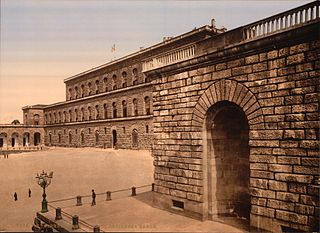
The Palazzo Pitti, in English sometimes called the Pitti Palace, is a vast, mainly Renaissance, palace in Florence, Italy. It is situated on the south side of the River Arno, a short distance from the Ponte Vecchio. The core of the present palazzo dates from 1458 and was originally the town residence of Luca Pitti, an ambitious Florentine banker.

The Palazzo Corsini is a prominent late-baroque palace in Rome, erected for the Corsini family between 1730 and 1740 as an elaboration of the prior building on the site, a 15th-century villa of the Riario family, based on designs of Ferdinando Fuga. It is located in the Trastevere section of the city, and stands beside the Villa Farnesina. During 1659–1689, the former Riario palace had hosted the eccentric Christina, Queen of Sweden, who abdicated, converted, and moved to Rome. Under her patronage, this was the site for the first meetings of the Roman Accademia dell'Arcadia.

Villa Feri is a villa in Florence, central Italy. It is known as "gentleman's villa" already in the 15th century.

Via de' Tornabuoni, or Via Tornabuoni, is a street at the center of Florence, Italy, that goes from Antinori square to ponte Santa Trinita, across Santa Trinita square, characterized by the presence of fashion boutiques.

The Barbadori Chapel, later Capponi Chapel, is a chapel in the church of Santa Felicita in Florence, central Italy. It was designed by Filippo Brunelleschi, and was later decorated by a cycle of works by the Mannerist painter Pontormo.
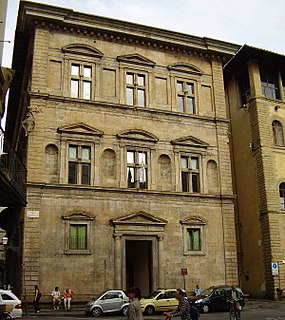
The Palazzo Bartolini Salimbeni is a High Renaissance-style palace located on Via de Tornabuoni on Piazza Trinita in central Florence, Tuscany, Italy.
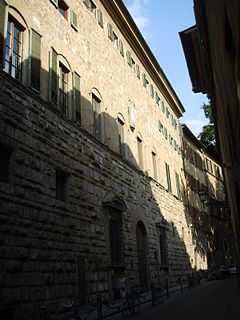
Palazzo Capponi alle Rovinate is a late-Gothic and early Renaissance-style residential palace located on Via de' Bardi in Florence, region of Tuscany, Italy. There are apparently three other palaces once associated with the Capponi family:

Palazzo Cocchi-Serristori is a Renaissance-style palace in Piazza Santa Croce, Florence, Italy. It presently houses offices of a regional council of Florence.
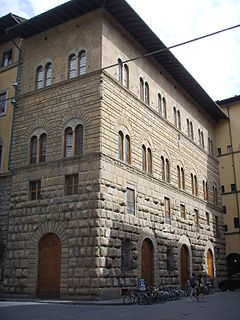
Palazzo dello Strozzino is a Renaissance palace in Florence, region of Tuscany, Italy. The stone Renaissance facade is located on Piazza degli Strozzi, diagonal to the Southeast corner of the imposing Palazzo Strozzi. The Northern façade on Via dei Anselmi houses the entrance to the Cinema Odeon.

The Palazzo Spannocchi is a Renaissance style urban palace located on the Piazza Salimbeni, just off Via Banchi di Sopra in the Terzo di Camollia of the city of Siena, region of Tuscany, Italy. The building was associated with an ancient mercantile family of Siena.

The Palazzo Borgherini-Rosselli del Turco is a Renaissance-style palace located in central Florence, region of Tuscany, Italy. It stands beside the church of Santi Apostoli. The palace was designed by Baccio d'Agnolo. From this palace, in 1529, were expropriated the chests containing panels painted by Jacopo Pontormo for the Borgherini.

The Palazzo Panciatichi is a Renaissance palace located on Via Camillo Cavour 2 in the quartiere of San Giovanni, Florence, region of Tuscany, Italy. A different Palazzo Panciatichi-Ximenes or Ximenes-da Sangallo is located at Borgo Pinti 68, corner of via Giusti, in Florence.

The Palazzo Nasi, also known as the Palazzo Torrigiani or Palazzo Scarlatti, is a palace located at Piazza de' Mozzi 4, down the street where the Ponte alle Grazie enters the Oltrarno, in Florence, Tuscany, Italy. Another Palazzo Torrigiani Del Nero, with a Mannerist or late-Renaissance-style facade stands closer to the river. Both palaces also once belonged to the Nasi. The palace is a few steps from the Palazzo Mozzi.
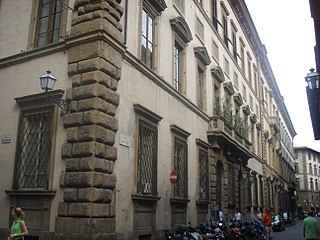
The Palazzo Pucci is a palace located at Via dei Pucci #4 in central Florence in the region of Tuscany, Italy. The façade of the palace spans from Via dei Servi to Via Ricasoli.
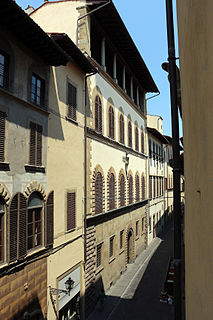
Palazzo Ginori is a Renaissance-style palace in Via de' Ginori # 11 in the Quartieri San Giovanni of the city of Florence, Italy.
The Palazzo Tempi, also known as Palazzo Vettori or Bargagli Petrucci, is a palace located along the Arno river at the narrow Piazza Santa Maria Soprarno 1, corner with Via de' Bardi and Costa dei Magnoli in the Oltrarno section of Florence, Tuscany, Italy. The palace is across the river from the Galleria of the Uffizi, and a block east of the Ponte Vecchio. The Via de' Bardi originates in an arch under the building.
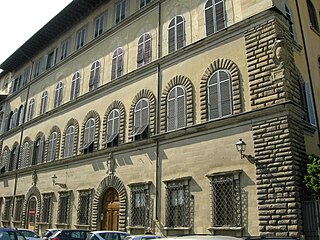
The Palazzo Torrigiani Del Nero is a Renaissance-style palace located at Piazza de' Mozzi 5, down the street where the Ponte alle Grazie enters the Oltrarno in Florence, Tuscany, Italy. Another Palazzo Torrigiani stands alongside, the smaller Palazzo Nasi. Both palaces also once belonged to the Nasi.

The Museo Horne is a museum focusing on art and furnishings of the 14th and 15th centuries, located in the former Palazzo Corsi, on via de' Benci number 6 in Florence, Tuscany, Italy.
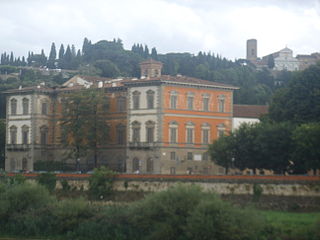
Palazzo Serristori is a Renaissance style palace located between Piazza Demidoff and the Lungarno Serristori in Oltrarno, in the neighborhood of San Niccolò of Florence, region of Tuscany, Italy.
Coordinates: 43°46′22.14″N11°15′4.06″E / 43.7728167°N 11.2511278°E